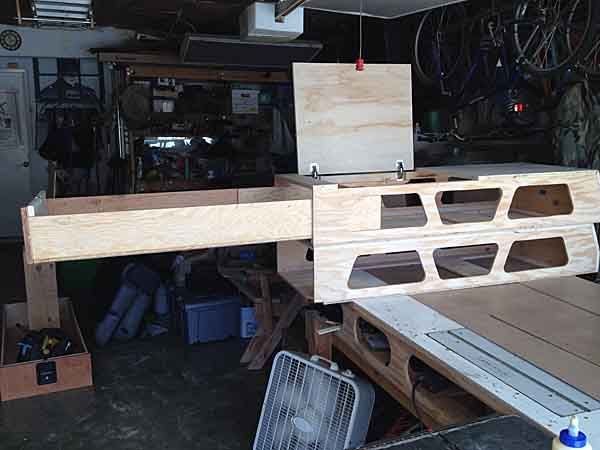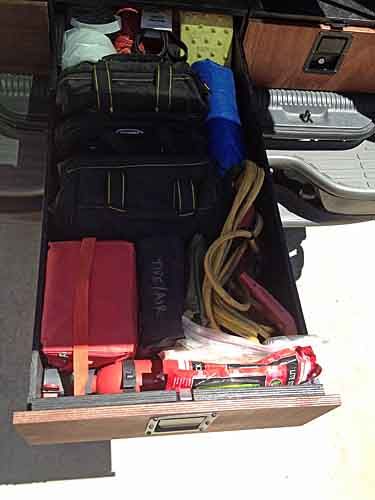I'm working on a trunk storage system for my '97 Jeep XJ and I want to create a dual extension counter top and drawer system, but I'm loath to lose any storage volume by sandwiching extra layers of plywood between each pair of slides. I'm trying to figure out how to stack the slides more efficiently.
Big picture, my goal is to create a modular, removable system that facilitates easy cooking out of the trunk and could be used in any vehicle. I want to install two identical boxes, side-by-side, each with its own pull-out counter top for prep and cooking. Below that counter top surface, I'll install a single drawer that will telescope out further beyond the counter. I plan to use Accurride lock-in/lock-out slides.
I've gleaned a ton of inspiration from ExPo and I'll be poaching more than a few good ideas; notably set-ups like uber's xj storage build, which is awesome. I hope he won't mind if I poach an image from his build as point of reference. As they say... imitation is the highest form of flattery!
Typically, dual extension systems are laid out like this:

That set-up is slick and reliable, but the downside is that it takes up a lot of space because you need to allocate room for three layers of plywood and two layers of slides. I figured that if I could manage to stack the slides vertically, then I could save some space. In my particular case, the extra thickness of a 1/2" wide heavy duty slide plus a 1/2" "sandwich" layer of plywood adds an inch to the assembly's thickness. In the instance of my 20" deep drawer x 8" tall, that's 1.1 cubic feet of storage volume used up in the assembly that could potentially be reclaimed.
So I'm trying to design a way to stack the slides, keeping the assembly thinner. The only way I can figure to accomplish this is to attach the slides together directly and reverse the orientation of the inner drawer slide, so that I can "outside-mount" the side of that inner drawer box, to the outside of the lower slide.
Here's a cross section of the layer build-up:

Hopefully that image can be zoomed so it's readable.
A few nuances:
The vertical "sandwich" layers that join everything will be made from 1/8" aluminum rather than plywood, to further reduce the assembly's thickness. I have a friend who can cut the plywood and aluminum on a CNC machine to make sure I keep exact tolerances so that the space between each layer can be kept pretty thin.
Because the inner drawer will be outside-mounted to the lower slide, the rear of the drawer box can't be very high because it would impact the lower slide, preventing the drawer from opening. This means the inner drawer box will be more like a tray than a true drawer box. To deal with the downside of not being able to stack items as high in a low profile tray, I plan to use insert boxes that can easily drop into the tray. The additional benefit will be the ability to quickly swap different gear sets in and out without repacking the drawers.
There's still refinement to do before I start cutting parts, so I thought that I'd reach out to see what insight and critical feedback the ExPo community may have; thoughts?
Big picture, my goal is to create a modular, removable system that facilitates easy cooking out of the trunk and could be used in any vehicle. I want to install two identical boxes, side-by-side, each with its own pull-out counter top for prep and cooking. Below that counter top surface, I'll install a single drawer that will telescope out further beyond the counter. I plan to use Accurride lock-in/lock-out slides.
I've gleaned a ton of inspiration from ExPo and I'll be poaching more than a few good ideas; notably set-ups like uber's xj storage build, which is awesome. I hope he won't mind if I poach an image from his build as point of reference. As they say... imitation is the highest form of flattery!
Typically, dual extension systems are laid out like this:

That set-up is slick and reliable, but the downside is that it takes up a lot of space because you need to allocate room for three layers of plywood and two layers of slides. I figured that if I could manage to stack the slides vertically, then I could save some space. In my particular case, the extra thickness of a 1/2" wide heavy duty slide plus a 1/2" "sandwich" layer of plywood adds an inch to the assembly's thickness. In the instance of my 20" deep drawer x 8" tall, that's 1.1 cubic feet of storage volume used up in the assembly that could potentially be reclaimed.
So I'm trying to design a way to stack the slides, keeping the assembly thinner. The only way I can figure to accomplish this is to attach the slides together directly and reverse the orientation of the inner drawer slide, so that I can "outside-mount" the side of that inner drawer box, to the outside of the lower slide.
Here's a cross section of the layer build-up:

Hopefully that image can be zoomed so it's readable.
A few nuances:
The vertical "sandwich" layers that join everything will be made from 1/8" aluminum rather than plywood, to further reduce the assembly's thickness. I have a friend who can cut the plywood and aluminum on a CNC machine to make sure I keep exact tolerances so that the space between each layer can be kept pretty thin.
Because the inner drawer will be outside-mounted to the lower slide, the rear of the drawer box can't be very high because it would impact the lower slide, preventing the drawer from opening. This means the inner drawer box will be more like a tray than a true drawer box. To deal with the downside of not being able to stack items as high in a low profile tray, I plan to use insert boxes that can easily drop into the tray. The additional benefit will be the ability to quickly swap different gear sets in and out without repacking the drawers.
There's still refinement to do before I start cutting parts, so I thought that I'd reach out to see what insight and critical feedback the ExPo community may have; thoughts?








